Abstract
The utilization of multi-sensor and constellation satellite data with appropriate geometric and radiometric calibration and validation is required for effective satellite data applications for various monitoring tasks. In this paper, we present the research and development of optical calibration sites using both natural surface and ground point-source-mirror reflectors constructed at The Center for Research and Application of Satellite Remote Sensing of Yamaguchi University (YUCARS), Japan. The YUCARS calibration sites experimented with GRUS-1A (Axelspace Corporation, Tokyo, Japan) and PlanetScope (Planet Lab, San Francisco, CA, USA) images for the verification of radiometric and geometric performance following the harmonized reflectance product. The top of atmosphere (TOA) radiance and reflectance of optical micro-satellite imageries were simulated by MODTRAN6 based on the in-situ data of the ground point-source-mirror reflector, ground surface and atmospheric measurements. The YUCARS mirror arrays were used to verify geometric accuracy and better band co-registration. The TOA reflectance derived from the ground measurements and acquired by satellite instruments were correlated to derive harmonization coefficients. The results show an improvement in image accuracy and harmonization of the different sensor data for the multi-temporal application. The preliminary results show that the mirror-arrays method can efficiently solve the limits of the external environment, time, and space. Furthermore, it can be used for improving radiometric performance and image quality using deblurring from a point spread function created from YUCARS mirror arrays.
1. Introduction
With the beginning of the New Space Ecosystem, microsatellites are becoming ubiquitous. The utilization of these multi-satellite sensor data for a given application requires harmonization of images. Harmonization in this research is implied as the radiometric and geometric adjustment of multi-sensor images for various applications. Therefore, the radiometric calibration of the optical satellite sensor is an essential procedure for satellite remote sensing data application to make it a reliable data source in the Earth observation system [1]. The Earth Observation (EO) satellite sensors are calibrated at a laboratory in the pre-launch phase with sensor characteristics and the acquired image calibrated using these sensor parameters. However, post-launch radiometric and geometric calibration is required to maintain the accuracy and consistency of the sensor parameters over the lifetime of EO satellite sensors. The vicarious calibration is widely used in post-launch sensor operations, and it can be performed through surface radiance/reflectance-based approaches presented by Chander et al. [2] and cross-calibration approaches between multiple sensors [3,4].
The motivation of this research project is to provide multi-sensor satellite images which are radiometrically and geometrically well-calibrated by means of vicarious calibration methods using ground mirror reflector, ground surface and atmospheric measurements. The estimated accuracy coefficient is used for the harmonization of the multi-sensor imageries by means of radiometric and geometric adjustment to the ground surface characteristics of the calibration sites. This is a critically important issue because the number of satellites has gradually increased in the last few years. Another important motivation is that image correction should consider specific environmental conditions surrounding the observation object. Earlier research experiments which were published by the authors showed that even the multi-temporal NDVI of the well-harmonized PlanetScope and GRUS-1 satellite constellations have different radiometric performances, despite being acquired on the same day [5]. For this reason, a new trend in calibration technology considers the development of standard artificial sites with the automatization of calibration procedures.
Harmonization coefficients can be estimated and verified by traditional and new methods of calibration. Traditional calibration has been successfully performed using artificial objects such as black, white, and grey tarps [6]. In the case of large-area calibration sites, there are two limitations—first, it is difficult to maintain these sites, and second, it is difficult to find a large unutilized area in Japan. Therefore, we adopted the point source-based calibration technique by utilizing a convex-mirror-array-based reflector.
This paper is organized as follows. After the introduction, in the second section, the steps of developing the calibration site are explained. Then, the next section mainly explains about the satellite constellations used in this study along with the equipment used in the measurement of various parameters. After this, the fourth section is about the methodology and various steps taken to achieve the desired results. Next, the fifth section provides deep insights into the various experiments, such as MODTRAN simulation, and the other results we obtained following the given methodology. Finally, the results are discussed and conclusions are provided in the last section.
2. Calibration Site Development
YUCARS builds calibration sites for optical satellite imageries using the calibration methods developed at the center. The accuracy estimation of satellite imageries at the center is focused on absolute vicarious calibration (AVC) and provides verified radiometric and geometric calibration for multi-satellite image harmonization for various application purposes. This approach requires performing radiometric calibration to absolute surface reflectance acquired at the observation point and the relative reflectance value derived from the satellite images among the multi-temporal observations. A technique for vicarious radiometric calibration has been described and used with ground surface reflectance and atmospheric properties [3,4] in satellite data applications. However, AVC uses pseudo-invariant calibration sites (PICS) which are spatially uniform and have stable spectral responses over time with high surface reflectance, and the atmospheric effects on upwelling radiance are minimal. The sites that have such specific properties are mostly located in the Sahara Desert in North Africa. For this reason, AVC activity has several difficulties because of the ground surface and atmospheric conditions, and it requires expensive field campaigns. Recently, researchers have looked for an efficient solution to overcome the environmental, time, space and expense limitations of calibration technology. The artificial point source is a new light source and technology for AVC in satellite remote sensing, and it is one of the crucial parts of calibration technology at the center.
2.1. Calibration Approach
The calibration is performed at the calibration sites with accurate scheduling satellite observation over the sites with ground data collections. The ground data collections include surface and point-source-mirror-array reflectance measurements (BOA- bottom of the atmosphere). At the same time, atmospheric transmittance is synchronously measured with a Microtops II Sunphotometer. The ground and atmospheric measurements with meteorological data are used as inputs in the radiative transfer model MODTRAN6, which estimates the solar energy at the top of the atmosphere (TOA) measured by the satellite sensor. The estimated TOA radiance and mirror-array coordinates allow the validation of satellite data accuracy and generate a harmonization coefficient for the satellite image. Such coefficients are generated for each spectral band of the satellite data. Then, the users can apply these coefficients to data correction, integration and harmonization. A general outline of the concept is given in Figure 1.
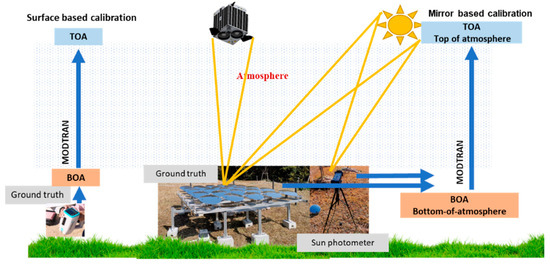
Figure 1.
Methodological concept of YUCARS Calibration.
2.2. Site Selection
The test sites for the YUCARS calibration method were chosen by considering several factors: environmental suitability, radiometric property from satellite images, accessibility, distance from YUCARS, and the capability of long-term use. Considering the above requirements, the sites were selected for ground and satellite measurements as shown in Figure 2.
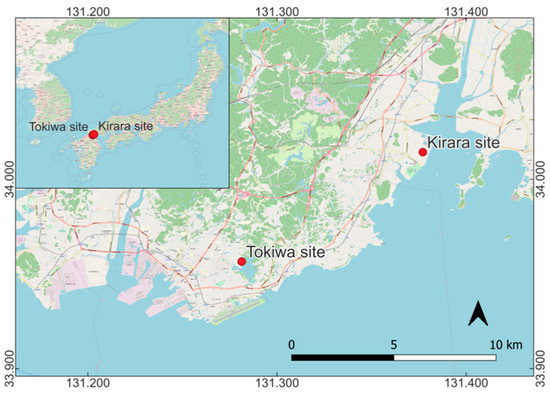
Figure 2.
Selected sites: Tokiwa site (33°57.393′N, 131°16.881′E) for the point source calibration and Kirara site (34°0.948′N, 131°22.698′E) for ground surface reflectance-based calibration.
2.3. Mirror Reflectivity Measurement
The point source reflector is the main equipment at the calibration site and an artificial point reflective target on the ground. The reflective target of YUCARS was built by an array of convex mirrors. The survey showed that the “acrylic” mirror had the highest reflectivity among the mirrors available at the market. The reflectivity of the mirror was estimated by laboratory measurement at Labsphere Inc. (North Sutton, NH, USA), as shown in Figure 3. The acrylic mirror provided 82–90% reflectance, compared with the stainless mirror with 47–53% reflectivity.
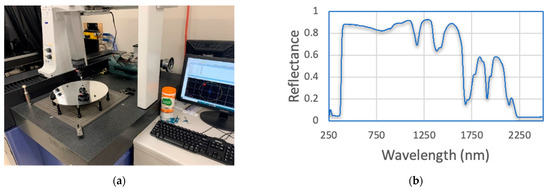
Figure 3.
Measurement of acrylic mirror reflectivity. (a) Measurement of mirror reflectivity at Labsphere Inc. (USA). (b) Reflective performance of the mirror at various wavelength.
The radiometric properties of the YUCARS mirror-array site were estimated using the SPARC method [7,8], and a configuration of the mirror site is shown in Table 1. Regarding the satellite sensor band characteristics, the reflectivity characteristics of the mirror-array site for the GRUS-1 satellite are described in Table 2. Concerning the satellite sensor with 5 m spatial resolution, the size and number of mirrors were calculated considering the reflectivity characteristics of the mirror site.

Table 1.
Mirror site parameters.

Table 2.
Reflectivity characteristics for individual bands of the GRUS-1 satellite.
2.4. Mirror Array Development
The mirror-array reflector was designed and constructed at Yamaguchi University. The mirror-array provides the flexibility of setting the tilt and azimuth angles by means of mirror rotation according to the satellite orbital information. The mirror-array was designed in such a way that setting the tilt and azimuth angle can be controlled by a few control keys, as shown in Figure 4.
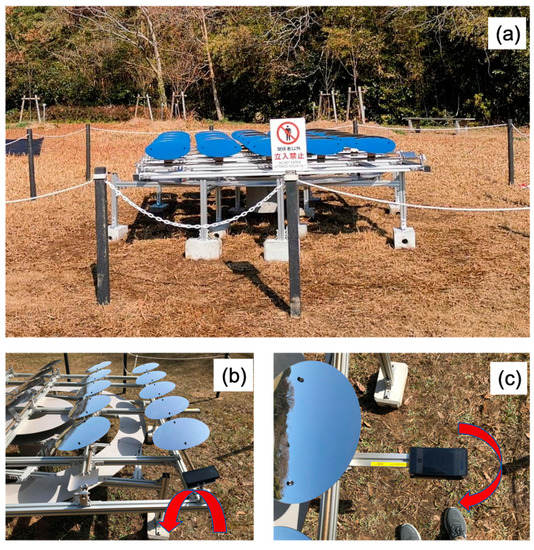
Figure 4.
YUCARS mirror-array site: (a) mirror-array desk; (b) control key for tilt angle; (c) control key for azimuth angle.
3. Satellite Constellation, Images and Equipment Used
3.1. Details about Satellite Constellation Sensors and Images Used
The constellations of the GRUS and PlanetScope satellites were used for data calibration at the YUCARS calibration sites. GRUS-1 can obtain panchromatic images (having sensitivity in all bands from visible to near-infrared and normally expressed in grayscale format) and multi-spectral images (having sensitivity only in a specific band; blue, green, red, red edge and near-infrared, respectively). The ground resolution is 2.5 m for panchromatic images, and 5.0 m for multi-spectral images. On the other hand, the PlanetScope constellation has various generations of optical instruments, and in this study, we used PlanetScope Dove and SuperDove sensors. Figure 5 shows the images used in the study, captured on the same day.

Figure 5.
The true colour images acquired by PlaneScope and GRUS-1 satellites.
This study used 3 satellite sensors’ data for the calibration, including GRUS-1A from Axelspace, Tokyo, Japan, Planet Scope PS2, and PSB.SD from Planet Lab, San Francisco, CA, USA. These 3 images were observed on the same day, 5 August 2021. The characteristics of each sensor are shown in Table 3 and Table 4 for GRUS-1 and PlanetScope satellite respectively.

Table 3.
GRUS-1 sensor characteristics.

Table 4.
PlanetScope sensor characteristics.
3.2. Equipment Used
YUCARS collected ground truth to estimate the sensor radiance of ground points as well as the measurement of atmospheric conditions. For atmospheric transmittance, a handheld Model 540 Microtops II with channels (380 nm, 500 nm, 675 nm, 870 nm, and 1020 nm) [9] for aerosol optical depth (AOD) was used.
The surface reflectance of the measurement points at the calibration site was measured by an ASD FieldSpec HandHeld 2 Spectroradiometer with a wavelength range of 325–1025 nm [10]. The location of the measurements is recorded was GPS Softbank’s high-precision positioning service “Ichimill” and handheld GPS Garmin Etrex20xJ (Figure 6).

Figure 6.
The equipment used for surface reflectance and other parameters measurement. (a) Sunphotometer Model 540 Microtops II. (b) ASD FieldSpec HandHeld 2 Spectroradiometer. (c) Ichimill GPS. (d) Garmin Etrex20xJ.
4. Methodology
The vicarious calibration using ground reflectance was proposed by Slater et al. (1987) [11], and this technique has been successfully used in satellite data calibration [12,13,14]. The vicarious radiometric calibration entirely depends on acquiring the ground object reflectance and accurate estimation of atmospheric transmittance over the calibration site during the satellite observation time. In this study, the proposed method was a validation and improvement of the satellite image accuracy based on vicarious calibration using a ground surface with artificial point source reflectance and satellite images. The validation consisted of two main parts—ground and satellite measurement (Figure 7). The satellite measurement was based on the standard classic approach of satellite remote sensing technology as data acquisition, pre-processing with accurate geometric correction and radiometric calibration using image metadata. The TOA radiance value at the satellite sensor for the measurement points was calculated.
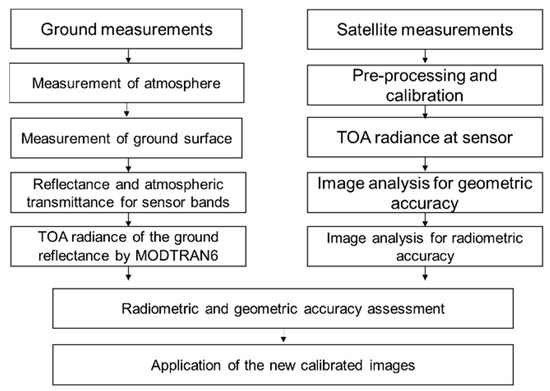
Figure 7.
Flow of Calibration methodology at YUCARS.
Simultaneously, the TOA radiance of the ground-measured reflectance over the observation points was estimated by the radiative transfer model MODTRAN6. The calibrated TOA at-sensor radiance was compared to the estimated TOA radiance by MODTRAN from the ground surface measurement. The difference between the two values was the radiometric accuracy of the satellite imageries used to create a harmonization coefficient for image application. A detailed description of methods used in the research is described below.
4.1. Vicarious Calibration through Ground Point Surface Reflectance
One of the proposed validation approaches for calibration accuracy is based on the ground surface reflectance method. This is the classic vicarious calibration method which proposes a validation site where accurate measurements of ground surface reflectance and estimation of TOA radiance value corresponding to the ground measurements are performed. The ground surface reflectance to estimate TOA radiance at the satellite sensor was collected on the natural grassland and bare soil of Kirara Park, Yamaguchi, Japan. A few random points were selected at the calibration site, ensuring that these points were homogenous and well spread all over the examined site. The surface reflectance of these points at the calibration site was measured by an ASD FieldSpec HandHeld 2 Spectroradiometer operating at a wavelength range of 325 nm–1025 nm. The reflectance acquired by the spectroradiometer was used to estimate the reflectance value of each spectral band of the satellite sensor. The location of these points was recorded by GPS Softbank’s high-precision positioning service “Ichimill” and Garmin Etrex20xJ.
4.2. Vicarious Calibration through Point Source Reflectance
Despite being the standard methodology and experimentation among many researchers, the classic vicarious calibration method based on the natural ground surface reflectance is highly site-specific, environmentally dependent, and also suffers from the dynamicity of the surface of the calibration site, which changes even during the calibration period. In order to rapidly and periodically monitor and evaluate the radiometric and geometric parameters of continuously operating satellite sensors, artificial targets or point source targets have great advantages and can be used as reference targets.
The point source reflector as an artificial point reflective target on the ground is the main equipment used in the calibration method. Mirror technology offers several benefits over traditional methodology [15]. The convex mirror-array as a point source for calibration analysis was constructed and installed at the YUCARS calibration site. The TOA radiance L(λ) (with unit Wm−2 sr−1 nm−1) for a sensor viewing mirror-array at a given angle θ for a single mirror was estimated as (1):
where:
: specular reflectance of the mirrors (unitless)
GSD: ground sample distance, cross/along (m)
E0: top of atmosphere solar irradiance (W/m2/nm)
τ↓: downwelling atmospheric transmittance, sun to mirror (unitless)
τ↑: upwelling atmospheric transmittance, mirror to sensor (unitless)
: mirror radius of curvature (m)
4.3. Atmospheric Transmittance
The one of the main steps in the vicarious calibration is to estimate TOA radiance from the ground reflectance measurements. TOA radiance calculation requires determining atmospheric transmission and scattering properties over the calibration site during the observation time. The downwelling atmospheric path from the sun to the ground surface and upwelling from the ground surface to the sensor were retrieved by the radiative transfer model MODTRAN6. The ground measurement data describing atmospheric conditions over the observation area included aerosol optical depth, water vapor and ozone volume, atmospheric pressure, air temperature and relative humidity [13]. The Microtops II 540 model was used to retrieve the atmospheric properties as inputs for MODTRAN6 to simulate TOA radiance at the sensor of the satellite used for the calibration analysis. The Microtops II Sunphotometer has also been used widely, and it is a well-known instrument among researchers around the world [9,16]. The data measurement of the atmospheric properties and the Ångström exponent was carried out as follows:
4.3.1. The Extraterrestrial Constant
The extraterrestrial constant (V0) was determined through the Langley method. The Langley method is a primary calibration procedure and estimates V0 through field measurements as in Equation (2).
where θ is the solar zenith angle, V is the measured voltage by Microtops II 540, and τ is the atmospheric optical thickness (including scattering and absorption by aerosol particles and gas molecules).
4.3.2. The Angstrom Coefficient
The Angstrom coefficient was calculated using two aerosol optical depth measurements by the sunphotometer Microtops II 540, specifically at 500 and 870 nm, and estimated using Equation (3).
where are estimated as . I and I0 are the measured solar irradiance at the ground and solar irradiance on TOA, respectively, and m is the air mass. Here, is the total optical thickness.
4.4. Satellite Images Analysis
GRUS satellite images were taken in 12-bit in the spacecraft’s onboard memory. Then, the ground processing system used radiometric correction to scale it to a 16-bit dynamic range. The absolute radiometric correction was used to transform the relative pixel’s DN value obtained straight from the sensor to the reflectance at the top of the atmosphere (TOA) [17]. Equation (4) can be used to convert the pixel value (DN) of multispectral image products of GRUS to TOA reflectance (Refsensor). For PlanetScope PS2 and PSB.SD instruments, the PlanetScope ortho tiles “Calibrated to top of atmosphere radiance (TOAR))” products were used and pre-processed [18].
4.5. TOA Radiance Estimation by MODTRAN
The TOA radiance value equal to the satellite sensor radiance was estimated from the measured ground surface reflectance and atmospheric data as the total optical depth, ozone, water vapor and aerosol and atmospheric pressure. The estimation was simulated by the radiative transfer model MODTRAN6 [19,20,21,22,23]. The MODTRAN (MODerate resolution atmospheric TRANsmission) model simulates atmospheric transmittance and calculates TOA radiance, single and multiple-scattered solar and thermal radiance. The graphical user interface (GUI) of the MODTRAN6 was used to run the simulation using radiative transfer options, ground measurements of surface reflectance, AOD, aerosols, water vapor content, and sun–target–sensor geometry along with the other required parameters. The GUI displayed output results together with graphical visualities. MODTRAN6 has multiple options which are available for running the processing. In this study, the GUI was used to run MODTRAN6 using JSON formatted input parameters (Figure 8). There were 6 primary group inputs: radiative transfer (RT) options, atmosphere, clouds and aerosols, geometry, surface and spectral options.
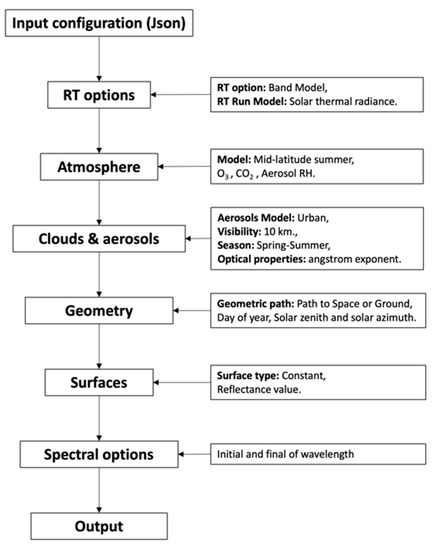
Figure 8.
MODTRAN6 input configuration file structure.
- RT options: the multiple scattering DISORT (DIScrete Ordinate Radiative Transfer) model with solar and thermal radiances mode was selected.
- Atmosphere options: the mid-latitude summer model with other parameters such as H2O, O3, CO2 and aerosol RH was selected.
- Clouds and aerosol options: no clouds, urban model with optical depth value, spring-summer season with user-defined aerosols and optical properties estimated by Microtops II 521&540 and Angstrom coefficient.
- Geometry options: path to space or ground with properly calculated parameters such as observer and zenith, target, day of the year, Earth radius, solar zenith and azimuth angles.
- Surface options: Lambertian surface type with the ground-measured reflectance estimated in accordance with the satellite sensor’s bands.
- Spectral options: band spectral characteristics including a width initial and final range with an increment, FWHM, wavelength unit, plot out file and spectral response function of the satellite bands. The input data for running MODTRAN6 are given in a JSON file (Appendix A).
A carbon dioxide concentration is required in the input parameter for MODTRAN6 simulation. The CO2 for the observation area was retrieved and used from the following source: https://ds.data.jma.go.jp/ghg/kanshi/ghgp/co2_trend.html (accessed on 11 October 2021).
For the above input data and configuration, MODTRAN6 generates TOA radiance in µWcm−2 sr−1 nm−1 unit. The output data are in CSV and JSON formats, which are requested in the input configuration.
The corresponding outputs of the simulation are given in a CSV file. Then, the estimated TOA radiance is compared to the observed sensor radiance. The difference between both radiances is the calibration coefficient. The total TOA radiance can be converted to the TOA reflectance (TOARef) using Equation (5):
where R is the TOA radiance, µ is the cosine of the solar zenith at the ground, and F is the solar flux at the TOA. The resulting TOA reflectance simulated from the ground measurement is compared with TOA reflectance measured by a satellite sensor. In such a way, the MODTRAN6 simulation procedure was performed for all bands of the GRUS-1, PS2, and PSB.SD satellite sensors and estimated TOA radiance, and consequently the reflectance value.
5. Experiment Results
5.1. Data Collection at the Ground Surface
The calibration was performed at the calibration sites (Kirara and Tokiwa Park) with accurate scheduling of the satellite observation over the sites and the ground data measurements. Before the measurement, the Microtops II sunphotometer was calibrated by Langley plotting, and a new V0 from the Langley plot was used for AOD estimation. In this study, it was used to estimate atmospheric properties such as the Angstrom exponent derived from ground-based measurement. This value determines the aerosol optical properties which were used in the MODTRAN simulation. Spectral data were processed based on the band wavelength of each sensor in the MODTRAN. At the same time, a spectroradiometer with a very accurate location by Ichimill GPS was used to measure surface reflectance, as shown in Figure 9a. The spectroradiometer provides reflectance as presented in Figure 9b. It is also used as an input in MODTRAN simulation according to the wavelength of each band and sensor.
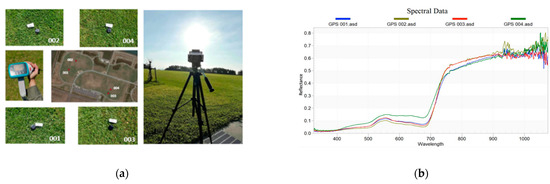
Figure 9.
(a) Ground measurement points and sunphotometer and (b) spectral properties of the ground surface points.
5.2. Atmospheric Measurements and Transmittance
5.2.1. Langley Calibration of Microtops II Sunphotometer
The calibration of the sunphotometer was performed using the Langley method and is a well-established methodology known worldwide [24]. This method aims to characterize atmospheric conditions accounting for local environmental parameters for the calibration site. The measurements for the Langley method were carried out at YUCARS and Kirara Park during a full day of non-cloudy sunny weather conditions while the solar zenith angle or the optical air mass was either decreasing or increasing continuously from 7:00 A.M. to 5:30 P.M. (Figure 10). The Langley plot was performed for each wavelength of the Microtops II using Equation (2) against airmass and it produced the coordinate intercept ln (V0), and consequently the extraterrestrial constant V0 was evaluated. The calibrated V0 from the Langley plots were updated to the corresponding instruments for the retrieval of atmospheric optical properties. Table 5 shows the extraterrestrial constant V0 of Microtops II model 540.
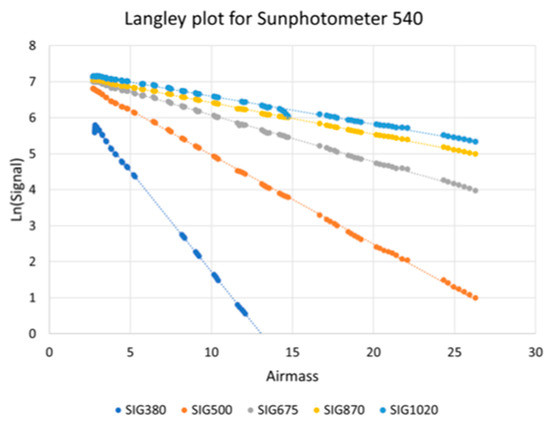
Figure 10.
Langley plot for Model 540 Microtops II measurement.

Table 5.
The estimated extraterrestrial constant V0 for Model 540’s bands.
5.2.2. Angstrom Coefficient
The ground measurements by Sunphotometer Model 540 provide various parameters which were used to calculate the AODs: AOD at 500 nm = 0.626 and AOD at 870 nm = 0.375. Further, Equation (3) from Section 4.3.2 was used to obtain the Angstrom coefficient, which equated to 0.926199004. This Angstrom coefficient was used as one of the necessary input parameters for TOA radiance estimation using MODTRAN6.
5.3. MODTRAN Simulation
MODTRAN6 with the DISORT model was used for estimating the TOA radiance of satellite images according to the respective sensor information (sensor zenith and azimuth) and in situ measurement of ground reflectance and atmospheric condition. Then, TOA radiance images were converted to TOA reflectance using the equation mentioned earlier. The simulated TOA radiance and reflectance for GRUS-1A, PS2, and PSB.SD are shown in Table 6, Table 7 and Table 8.

Table 6.
Simulated GRUS-1A TOA radiance and reflectance.

Table 7.
Simulated PlanetScope (PS2) TOA radiance and reflectance.

Table 8.
Simulated PlanetScope (PSB.SD) TOA radiance and reflectance.
5.4. Comparison of Simulated MODTRAN and Satellites TOA
In this section, we use absolute radiometric correction to transform the reflectance at the top of the atmosphere (TOA) using Equation (5). Afterwards, we compare the estimated TOA reflectance from MODTRAN with the TOA reflectance of GRUS-1A, PS2, and PSB.SD images, as presented in Figure 11 and Table 9.

Figure 11.
Comparison between predicted TOA reflectance by MODTRAN and TOA reflectance of various satellites—(a) GRUS-1A (b) PS2 (c) PSB.SD.

Table 9.
Comparison of TOA radiance estimated by MODTRAN and satellite images (Highlighted).
5.5. Calibration Coefficient Calculation for TOA Radiance and Reflectance
The calibrated TOA radiance of the satellite data is validated by the vicarious calibration method using the ground measurement reflectance of the calibration sites. The results show different accuracies in each band of the satellite image, and this is the main reason to harmonize multi-sensor images for multi-temporal data application. TOA values (all bands combined) between the satellite and MODTRAN were used to create calibration equations for each sensor, as shown in Figure 12 (radiance) and Figure 13 (reflectance). In this study, we used these derived equations mentioned in Figure 13 to adjust satellite reflectance to calibrated reflectance.
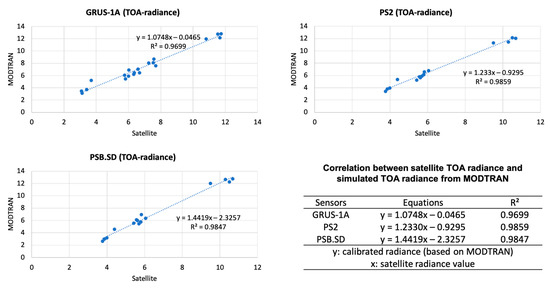
Figure 12.
TOA radiance of various sensors and corresponding correlation coefficients.
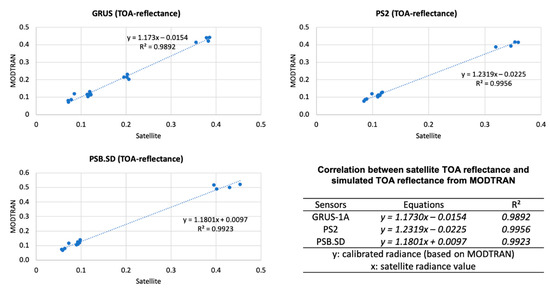
Figure 13.
TOA reflectance of various sensors and corresponding correlation coefficients.
5.6. Calibration Coefficient for Image Harmonization
The equations derived from the correlation between the satellite images and MODTRAN simulations were used to correct band data and the produced NDVI images. Figure 14 shows NDVI image scenes before calibration and after calibration from the respective satellites, GRUS and PlanetScope (PS2 and PSB.SD). Before calibration, each image scene shows varying NDVI values resulting from the different color tones in the image. The GRUS-1 image has different NDVI values in comparison to the other sensors. This phenomenon can be better seen in the case of water areas in the GRUS-1 image. Similarly, the PSB.SD image shows a higher NDVI value, leading to the darker tone of the image. After calibration, the images show a harmonized range of NDVI values, which will help to utilize multi-sensor data for accurate land monitoring.
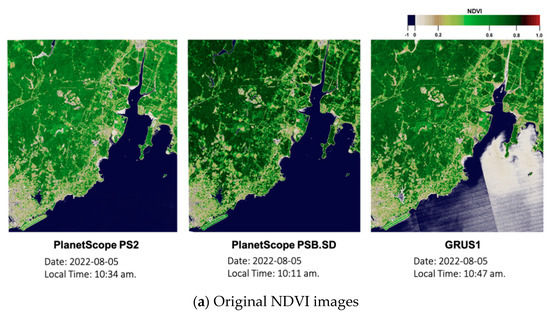
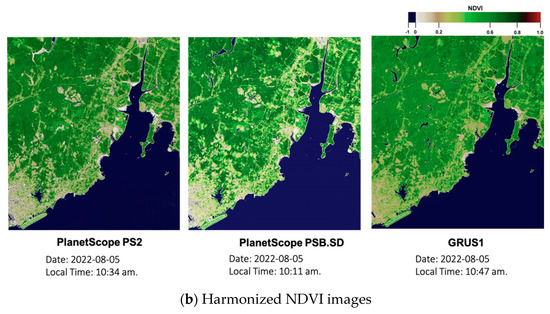
Figure 14.
PlanetScope PS2, PSB.SD and GRUS-1A before (a) and after (b) harmonization using the calibration coefficient.
5.7. Image Correction Using a Mirror-Array
5.7.1. Geometric Correction
The acquired GRUS-1A images were calibrated using the mirror-array station at the Tokiwa site of Yamaguchi University (Figure 15a). Sunlight energy reflected from the mirror-array was effectively detected by the sensor, which can be seen as bright pixels in the image. The mirror-array pixels in the satellite image were analyzed to estimate the energy distribution around the center of the mirror-array and the band-to-band registration accuracy to improve image quality for further application. A central point of the mirror-array station was precisely measured by the GPS, and it can be positioned on the image pixel with sub-pixel accuracy. The geometric accuracy of the individual RGB bands and false-colour RGB image is shown in Figure 15b. The mirror-array shows that the single band has different locational accuracy, at 2.5–12.5 m. The difference in pixel location in the RGB bands leads to poor band registration accuracy, and it causes an image blurring effect in a color-composite false-color image generated from the GRUS-1A multi-spectral bands. The precise estimation of sub-pixel accuracy allows us to improve band registration and generate better color composites as true and false-color images from multi-spectral bands. The color-composite image will make it possible to generate better pan-sharpening from panchromatic band data.

Figure 15.
(a) Mirror-array detected by GRUS-1A (inside the circle). (b) The original and corrected images of GRUS-1A data acquired on 26 April 2021.
5.7.2. Energy Distribution of Mirror-Array
The mirror-array station has a strong potential to analyze the energy spread of each band from the mirror station center, and plotting in 3D can estimate radiometric and geometric accuracy. The spread and intensity of light energy reflected by the mirror-array can be analyzed using the pixel value after precise geometric correction. Distribution of the RGB band’s light intensity around the mirror-array center will make it possible to construct a point spread function of an in-flight image. Figure 16 shows a spread of reflected energy from the mirror-array at the Tokiwa calibration site of Yamaguchi University.
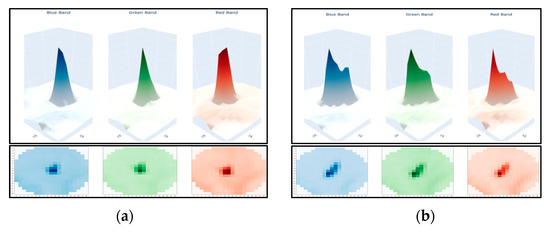
Figure 16.
Energy spread of mirror pixels of the individual bands (Blue, Green, Red) of GRUS-1A around the mirror-array center: (a) 26 April 2021 and (b) 5 August 2021.
A comparison of two images taken on 26 April and 5 August 2021 clearly shows a difference in energy distribution and spreading around the center. The energy from the mirror-array is better represented in the example GRUS image from April 26 than the August 5 image. This led to the motion blurring phenomenon in the satellite image from 5 August 2021. As per the mirror reflective property, the energy in all of the bands should be higher/lower at the same pixel. However, in the MSI satellite, image bands might be shifted or misregistered during product development due to various factors, as shown in the 26 April 2021 image. This image has a misregistration of the red band with the corresponding green and blue bands. On the other hand, the 5 August image shows well-registered bands, as can be seen in the contour lines of the plots.
The analysis of mirror pixel’s energy spread from the center describes the band pixel’s radiometric and geometric accuracy status of the image, which can be input parameters describing the point spread function. The analysis of the satellite image based on the mirror-array shows the potentiality of precise correction of band registration accuracy and estimation of a spreading level of the pixel reflectance around the mirror panel. The calculated positional error was used to improve band registration accuracy and the original band data were re-constructed into new images. The corrected bands were used to generate new color-composite true-color images (Figure 17).
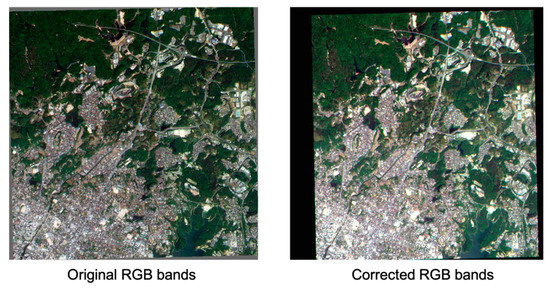
Figure 17.
The original and corrected color composite of RGB bands from GRUS-1A.
6. Discussion and Conclusions
A calibration and harmonization method for micro-satellite imageries based on the reflectance of ground point source-mirror reflectors and the ground surface is investigated here. For this, two calibration sites were prepared, one using convex mirrors reflectors and another using natural ground surface reflectance measurements. The TOA radiance and reflectance of optical micro-satellite imageries are calculated on the basis of the absolute calibration method by using the in-situ data of ground point-source-mirror reflector, ground surface and atmospheric measurements. This method is used to verify the radiometric and geometric accuracy for the integration and harmonization of multi-sensor images.
The mirror-array reflector was constructed and established at Tokiwa Park of Ube city, Yamaguchi prefecture, Japan. The Tokiwa site, consisting of a mirror-array, was newly constructed, and it allows the application of mirror as a point-source for satellite data calibration, different from the traditional method. The Kirara site is mainly used for vicarious calibration based on ground surface reflectance measurements to estimate radiometric consistency between satellite sensors and establish harmonization factors for multi-temporal data applications.
These two sites have successfully experimented with GRUS-1A and PlanetScope satellite data for multi-sensor image calibration and harmonization. This opens up the future prospects of the calibration sites for multi-satellite data harmonization, calibration, integration and consistent image quality for various applications and monitoring.
MODTRAN6 with the DISORT model was used to estimate TOA radiance from the in-situ data such as ground surface reflectance measured by spectroradiometer and atmospheric properties measured by Microtops II Sunphotometer. Then, TOA radiance of the ground measurement was converted to TOA reflectance. The estimated TOA radiance and reflectance were compared with the measured radiance and reflectance from the satellites. The proposed method found that the percent difference between the TOA reflectance of the GRUS-1A sensor and ground measurements has a range from − to 2.246%. The PlanetScope PS2 instrument has a range from to . The PSB.SD of PlanetScope has a range between and . The correlation between TOA reflectance at the satellite sensor and MODTRAN’s simulations was used to create calibration equations for multi-imageries harmonization and was applied to GRUS-1A and PlanetScope images. The comparison between the before and after calibration data shows well-harmonized NDVI color images. The successful experimental results indicated a practical approach for future multi-sensor data applications with enhanced and improved calibrated and harmonized imageries of large and micro-satellite platforms.
One of the time-consuming processes in the satellite image validation activity is the calculation of geometric precision. This study utilized mirror-array reflectors to estimate a satellite image pixel location from the mirror center to determine sub-pixel accuracy. The estimation result will enable us to precisely assess the satellite image’s band registration correctness, which is crucial for assessing the image-defocusing effect. Better co-registration leads to a higher-quality RGB composite true color image. Moreover, the mirror-array reflector has a strong ability to assess sensor radiometric performance via plotting a spread of reflected energy from the mirror center for the different bands in addition to geometric accuracy estimations. This will make it possible to build a point spread function that has a great chance of enhancing image quality through deblurring and defocusing methods. The initial findings of the radiometric and geometric accuracy estimation indicate that the suggested method can be used to validate multi-sensor imageries to increase the consistency and accuracy of the images. The harmonized images will add value and perform better for multi-temporal and multi-satellite data applications.
In future, with the availability of more image pairs, further analysis and investigation will take place, particularly taking into account the image calibration technique, employing the in-flight point spread function based on ground mirror-array points. Further improvement requires a proper validation of the proposed method with an uncertainty evaluation estimate, which will be possible with multi-pair images.
Author Contributions
Conceptualization, D.I. and M.N.; Data curation, D.I., N.T., T.E. and Y.N.; Formal analysis, D.I., N.T. and V.K.; Funding acquisition, M.N.; Investigation, N.T. and Y.N.; Methodology, D.I., N.T. and V.K.; Project administration, M.N.; Supervision, D.I. and M.N.; Validation, D.I., N.T., V.K. and T.E.; Writing—original draft, D.I., N.T. and V.K.; Writing—review and editing, D.I., M.N., N.T., V.K., T.E. and Y.N. All authors have read and agreed to the published version of the manuscript.
Funding
This work was supported by MEXT Coordination Funds for Promoting AeroSpace Utilization; Grant Number JPJ000959.
Data Availability Statement
Not applicable.
Acknowledgments
The authors thank Axelspace Corporation (Japan) and Planet Labs PBC(USA) for providing the images from GRUS-1 and PlanetScope constellation. We would like to thank Chris Durell and Brandon Russell of Labsphere, Inc for their help in mirror reflectivity estimation and detailed discussion during the research. Along with this, we also want to acknowledge Alexander Berk of Spectral Sciences, Inc. for the guidance of MODTRAN6 simulation and Chris Voth of Solar Light company (USA) for providing support during Microtops II measurement.
Conflicts of Interest
The authors declare no conflict of interest.
Appendix A
MODTRAN6 Input JSON File for GRUS-1A Red Band
This is a sample of the JSON file used as an Input for MODTRAN6 for estimating the TOA radiance.
{
“MODTRAN”: [
{
“MODTRANINPUT”: {
“NAME”:
“mod6”,
“DESCRIPTION”:
“”,
“CASE”: 0,
“RTOPTIONS”: {
“MODTRN”:
“RT_MODTRAN”,
“LYMOLC”: false,
“T_BEST”: false,
“IEMSCT”:
“RT_SOLAR_AND_THERMAL”,
“IMULT”:
“RT_DISORT”,
“DISALB”: true,
“NSTR”: 8,
“SOLCON”: 0.0
},
“ATMOSPHERE”: {
“M1”:
“ATM_MIDLAT_SUMMER”,
“M2”:
“ATM_MIDLAT_SUMMER”,
“M3”:
“ATM_MIDLAT_SUMMER",
“M4":
“ATM_MIDLAT_SUMMER",
“M5":
“ATM_MIDLAT_SUMMER",
“M6":
“ATM_MIDLAT_SUMMER",
“CO2MX": 440.0,
“H2OSTR": 32.277,
“H2OUNIT":
“g",
“O3STR": 0.3,
“O3UNIT":
“a",
“C_PROF": 3,
“AERRH": 79.0,
“S_UMIX": [ 1.0, 1.0,
1.05, 1.0, 1.0, 1.0, 1.0, 1.0, 1.0, 1.0],
“S_XSEC": [ 1.674,
2.17, 1.0, 1.0, 1.0, 3.758, 1.0, 1.0, 1.0, 1.0, 1.0, 0.629, 1.0],
“E_MASS": 1.0
},
“AEROSOLS": {
“CDASTM":
“T",
"ASTMX": 0.926,
“IHAZE":
“AER_URBAN",
“ISEASN":
“SEASN_SPRING_SUMMER",
“VIS": 10.0
},
“GEOMETRY": {
“ITYPE": 3,
“H1ALT": 100.0,
“OBSZEN": 175.16,
“IDAY": 217,
"IPARM": 12,
“PARM1":
123.30000305175781,
“PARM2":
26.290000915527344
},
“SURFACE": {
“SURFTYPE":
“REFL_CONSTANT",
“SURREF": 0.08,
“GNDALT": 0.01,
“NSURF": 1,
“SALBFL":
“"
},
“SPECTRAL": {
“V1": 620.0,
“V2": 685.0,
“DV": 1.0,
“FWHM": 2.0,
“YFLAG":
“R",
“XFLAG":
“N",
“FLAGS": “NGAA
T"
},
“FILEOPTIONS": {
“JSONOPT":
“WRT_ALL",
“SLIPRNT":
“GRUS1A_20210805_REDsli",
“CSVPRNT":
“GRUS1A_20210805_RED.csv",
“JSONPRNT":
“GRUS1A_20210805_RED.json",
“FLROOT":
“mod6"
}
}
},
{
“MODTRANINPUT": {
“NAME":
“mod6",
“DESCRIPTION":
“",
“CASE": 0,
“RTOPTIONS": {
“MODTRN":
“RT_MODTRAN",
“LYMOLC": false,
“T_BEST": false,
“IEMSCT":
“RT_SOLAR_AND_THERMAL",
“IMULT":
“RT_DISORT",
“DISALB": true,
“NSTR": 8,
“SOLCON": 0.0
},
“ATMOSPHERE": {
“M1":
“ATM_MIDLAT_SUMMER",
“M2":
“ATM_MIDLAT_SUMMER",
“M3":
“ATM_MIDLAT_SUMMER",
“M4":
“ATM_MIDLAT_SUMMER",
“M5":
“ATM_MIDLAT_SUMMER",
“M6":
“ATM_MIDLAT_SUMMER",
“CO2MX": 440.0,
“H2OSTR": 32.277,
“H2OUNIT":
“g",
“O3STR": 0.3,
"O3UNIT":
“a",
“C_PROF": 3,
“AERRH": 79.0,
“S_UMIX": [ 1.0, 1.0,
1.05, 1.0, 1.0, 1.0, 1.0, 1.0, 1.0, 1.0],
“S_XSEC": [ 1.674,
2.17, 1.0, 1.0, 1.0, 3.758, 1.0, 1.0, 1.0, 1.0, 1.0, 0.629, 1.0],
“E_MASS": 1.0
},
“AEROSOLS": {
“CDASTM":
“T",
“ASTMX": 0.926,
“IHAZE":
“AER_URBAN",
“ISEASN":
“SEASN_SPRING_SUMMER",
“VIS": 10.0
},
“GEOMETRY": {
“ITYPE": 3,
“H1ALT": 100.0,
“OBSZEN": 175.16,
“IDAY": 217,
“IPARM": 12,
“PARM1":
123.30000305175781,
“PARM2":
26.290000915527344
},
“SURFACE": {
“SURFTYPE": "REFL_CONSTANT",
“SURREF": 0.059,
“GNDALT": 0.01,
“NSURF": 1,
“SALBFL":
“"
},
“SPECTRAL": {
“V1": 620.0,
“V2": 685.0,
“DV": 1.0,
“FWHM": 2.0,
“YFLAG": "R",
“XFLAG":
“N",
“FLAGS": “NGAA
T"
},
“FILEOPTIONS": {
“JSONOPT":
“WRT_ALL",
“SLIPRNT":
“GRUS1A_20210805_REDsli",
“CSVPRNT":
“GRUS1A_20210805_RED.csv",
“JSONPRNT":
“GRUS1A_20210805_RED.json",
“FLROOT":
“mod6"
}
}
},
{
“MODTRANINPUT": {
“NAME":
“mod6",
“DESCRIPTION":
“",
“CASE": 0,
"RTOPTIONS": {
“MODTRN":
“RT_MODTRAN",
“LYMOLC": false,
“T_BEST": false,
“IEMSCT":
“RT_SOLAR_AND_THERMAL",
“IMULT":
“RT_DISORT",
“DISALB": true,
“NSTR": 8,
“SOLCON": 0.0
},
“ATMOSPHERE": {
“M1":
“ATM_MIDLAT_SUMMER",
“M2":
“ATM_MIDLAT_SUMMER",
“M3":
“ATM_MIDLAT_SUMMER",
“M4":
“ATM_MIDLAT_SUMMER",
“M5":
“ATM_MIDLAT_SUMMER",
“M6":
“ATM_MIDLAT_SUMMER",
“CO2MX": 440.0,
“H2OSTR": 32.277,
“H2OUNIT":
“g",
“O3STR": 0.3,
“O3UNIT":
“a",
“C_PROF": 3,
“AERRH": 79.0,
"S_UMIX": [ 1.0, 1.0,
1.05, 1.0, 1.0, 1.0, 1.0, 1.0, 1.0, 1.0],
“S_XSEC": [ 1.674,
2.17, 1.0, 1.0, 1.0, 3.758, 1.0, 1.0, 1.0, 1.0, 1.0, 0.629, 1.0],
“E_MASS": 1.0
},
“AEROSOLS": {
“CDASTM":
“T",
“ASTMX": 0.926,
“IHAZE":
“AER_URBAN",
“ISEASN":
“SEASN_SPRING_SUMMER",
“VIS": 10.0
},
“GEOMETRY": {
“ITYPE": 3,
“H1ALT": 100.0,
“OBSZEN": 175.16,
“IDAY": 217,
“IPARM": 12,
“PARM1":
123.30000305175781,
“PARM2":
26.290000915527344
},
“SURFACE": {
“SURFTYPE":
“REFL_CONSTANT",
“SURREF": 0.072,
“GNDALT": 0.01,
“NSURF": 1,
“SALBFL":
“"
},
“SPECTRAL": {
“V1": 620.0,
“V2": 685.0,
“DV": 1.0,
“FWHM": 2.0,
“YFLAG":
“R",
“XFLAG":
“N",
“FLAGS": “NGAA
T"
},
“FILEOPTIONS": {
“JSONOPT":
“WRT_ALL",
“SLIPRNT":
“GRUS1A_20210805_REDsli",
“CSVPRNT":
“GRUS1A_20210805_RED.csv",
“JSONPRNT":
“GRUS1A_20210805_RED.json",
“FLROOT":
“mod6"
}
}
},
{
“MODTRANINPUT": {
“NAME":
“mod6",
“DESCRIPTION":
“",
“CASE": 0,
“RTOPTIONS": {
“MODTRN":
“RT_MODTRAN",
“LYMOLC": false,
“T_BEST": false,
“IEMSCT":
“RT_SOLAR_AND_THERMAL",
“IMULT":
“RT_DISORT",
“DISALB": true,
“NSTR": 8,
“SOLCON": 0.0
},
“ATMOSPHERE": {
“M1":
“ATM_MIDLAT_SUMMER",
“M2":
“ATM_MIDLAT_SUMMER",
“M3":
“ATM_MIDLAT_SUMMER",
“M4":
“ATM_MIDLAT_SUMMER",
“M5":
“ATM_MIDLAT_SUMMER",
“M6":
“ATM_MIDLAT_SUMMER",
“CO2MX": 440.0,
“H2OSTR": 32.2777,
“H2OUNIT":
“g",
“O3STR": 0.3,
“O3UNIT":
“a",
“C_PROF": 3,
“AERRH": 79.0,
“S_UMIX": [ 1.0, 1.0,
1.05, 1.0, 1.0, 1.0, 1.0, 1.0, 1.0, 1.0],
“S_XSEC": [ 1.674,
2.17, 1.0, 1.0, 1.0, 3.758, 1.0, 1.0, 1.0, 1.0, 1.0, 0.629, 1.0],
“E_MASS": 1.0
},
“AEROSOLS": {
“CDASTM":
“T",
“ASTMX": 0.926,
“IHAZE":
“AER_URBAN",
“ISEASN":
“SEASN_SPRING_SUMMER",
“VIS": 10.0
},
“GEOMETRY": {
“ITYPE": 3,
“H1ALT": 100.0,
“OBSZEN": 175.16,
“IDAY": 217,
“IPARM": 12,
“PARM1":
123.30000305175781,
“PARM2":
26.290000915527344
},
“SURFACE": {
“SURFTYPE":
“REFL_CONSTANT",
“SURREF": 0.133,
“GNDALT": 0.01,
“NSURF": 1,
“SALBFL":
“"
},
“SPECTRAL": {
“V1": 620.0,
“V2": 685.0,
“DV": 1.0,
“FWHM": 2.0,
“YFLAG":
“R",
“XFLAG":
“N",
“FLAGS": “NGAA
T"
},
“FILEOPTIONS": {
“JSONOPT":
“WRT_ALL",
“SLIPRNT":
“GRUS1A_20210805_REDsli",
“CSVPRNT":
“GRUS1A_20210805_RED.csv",
“JSONPRNT":
“GRUS1A_20210805_RED.json",
“FLROOT":
“mod6"
}
}
}
]
}
References
- Helder, D.; Thome, K.J.; Mishra, N.; Chander, G.; Xiong, X.; Angal, A.; Choi, T. Absolute Radiometric Calibration of Landsat Using a Pseudo Invariant Calibration Site. IEEE Trans. Geosci. Remote Sens. 2013, 51, 1360–1369. [Google Scholar] [CrossRef]
- Chander, G.; Markham, B. Revised Landsat-5 TM Radiometrie Calibration Procedures and Postcalibration Dynamic Ranges. IEEE Trans. Geosci. Remote Sens. 2003, 41, 2674–2677. [Google Scholar] [CrossRef]
- Shin, D.Y.; Ahn, H.Y.; Lee, S.G.; Choi, C.U.; Kim, J.S. Radiometric Cross-Calibration of KOMPSAT-3A with Landsat-8. Int. Arch. Photogramm. Remote Sens. Spat. Inf. Sci.—ISPRS Arch. 2016, 379–382. [Google Scholar] [CrossRef]
- Nag, S.; Dabney, P.; Ravindra, V.; Anderson, C. Planning a Reference Constellation for Radiometric Cross-Calibration of Commercial Earth Observing Sensors. arXiv 2020, arXiv:2010.09946. [Google Scholar]
- Tamkuan, N.; Ichikawa, D.; Katiyar, V.; Nagai, Y.; Eguchi, T.; Nagai, M. Optical Multi-Satellite Data Calibration for Image Integration and Harmonization. In Proceedings of the International Geoscience and Remote Sensing Symposium, (IGARSS 2022), Kuala Lumpur, Malaysia, 17–22 July 2022; pp. 4595–4598. [Google Scholar]
- Yeom, J.M.; Ko, J.; Hwang, J.; Lee, C.S.; Choi, C.U.; Jeong, S. Updating Absolute Radiometric Characteristics for KOMPSAT-3 and KOMPSAT-3A Multispectral Imaging Sensors Using Well-Characterized Pseudo-Invariant Tarps and Microtops II. Remote Sens. 2018, 10, 697. [Google Scholar] [CrossRef]
- Schiller, S.J.; Silny, J. The Specular Array Radiometric Calibration (SPARC) Method: A New Approach for Absolute Vicarious Calibration in the Solar Reflective Spectrum. In Remote Sensing System Engineering III; SPIE: Bellingham, WA, USA, 2010; Volume 7813. [Google Scholar]
- Schiller, S.J.; Teter, M.; Silny, J. Comprehensive Vicarious Calibration and Characterization of a Small Satellite Constellation Using Specular Array Calibration (SPARC) Method. In Proceedings of the Small Satellite Conference, Logan, UT, USA, 5–10 August 2017. [Google Scholar]
- Solar Light Company. User’s Guide MICROTOPS II, Sunphotometer Version 5.6; Solar Light Company: Glenside, PA, USA, 2011; ISBN 2155178700. [Google Scholar]
- ASD FieldSpec® HandHeld 2 User Manual. 2010, pp. 1–140. Available online: http://www.geo-informatie.nl/courses/grs60312/material2017/manuals/600860-Dhh2manual.Pdf (accessed on 10 July 2021).
- Slater, P.N.; Biggar, S.F.; Holm, R.G.; Jackson, R.D.; Mao, Y.; Moran, M.S.; Palmer, J.M.; Yuan, B. Reflectance- and Radiance-Based Methods for the in-Flight Absolute Calibration of Multispectral Sensors. Remote Sens Environ. 1987, 22, 11–37. [Google Scholar] [CrossRef]
- Biggar, S.F.; Dinguirard, M.C.; Gellman, D.I.; Henry, P.J.; Jackson, R.D.; Moran, M.S.; Slater, P.N. Radiometric Calibration of SPOT 2 HRV: A Comparison of Three Methods. In Proceedings of the Calibration of Passive Remote Observing Optical and Microwave Instrumentation, Orlando, FL, USA, 3–5 April 1991; SPIE: Bellingham, WA, USA, 1991; Volume 1493, pp. 155–162. [Google Scholar]
- Moran, M.S.; Henry, P.J.; Biggar, S.F.; Gellman, D.I.; Thome, K.J.; Slater, P.N.; Dinguirard, M.C. Review of SPOT-1 and -2 Calibrations at White Sands from Launch to the Present; SPIE: Bellingham, WA, USA, 2005; p. 14. [Google Scholar]
- Russell, B.; Scharpf, D.; Holt, J.; Arnold, W.; Durell, C.N.; Jablonski, J.; Conran, D.; Schiller, S.J.; Leigh, L.; Aaron, D.; et al. Initial Results of the FLARE Vicarious Calibration Network. In Earth Observing Systems XXV; SPIE: Bellingham, WA, USA, 2020; p. 14. [Google Scholar]
- Russell, B.; Holt, J.; Durell, C.; Arnold, W.; Conran, D.; Jumpasut, A.; Colm, L.; Schiller, S. The FLARE Network: Vicarious Cal/Val for Earth Observation Satellites. In Proceedings of the AIAA/USU Conference on Small Satellites, Logan, UT, USA, 7–12 August 2021. [Google Scholar]
- Ichoku, C.; Levy, R.; Kaufman, Y.J.; Remer, L.A.; Li, R.-R.; Martins, V.J.; Holben, B.N.; Abuhassan, N.; Slutsker, I.; Eck, T.F.; et al. Analysis of the Performance Characteristics of the Five-Channel Microtops II Sun Photometer for Measuring Aerosol Optical Thickness and Precipitable Water Vapor. J. Geophys. Res. 2002, 107, 4179. [Google Scholar] [CrossRef]
- AxelGlobe. AxelGlobe Image Specification Sheet Change History. Available online: https://docs.axelglobe.com/en/image-specifications (accessed on 21 September 2021).
- Planet Labs Inc. PlanetScope Product Specification. Available online: https://assets.planet.com/docs/Planet_PSScene_Imagery_Product_Spec_June_2021.pdf (accessed on 10 September 2021).
- Berk, A.; Anderson, G.P.; Acharya, P.K.; Shettle, E.P. MODTRAN®5.2.1 User’s Manual. Available online: https://citeseerx.ist.psu.edu/viewdoc/download?doi=10.1.1.458.1743&rep=rep1&type=pdf (accessed on 15 August 2021).
- Berk, A.; van den Bosch, J.; Hawes, F.; Perkins, T.; Conforti, P.; Acharya, P.K.; Anderson, G.P.; Kennett, R.G. MODTRAN®6.0 User’s Manual. Available online: https://wiki.harvard.edu/confluence/display/hufasstubbsgroup/MODTRAN6%2C+2022?preview=/301915384/301915472/MODTRAN6User%27sManual.pdf (accessed on 17 August 2021).
- Berk, A. MODTRAN—Radiative Transfer. Available online: https://www.spectral.com/our-software/modtran/ (accessed on 20 October 2021).
- Ross, V. Validation of the MODTRAN 6 Refracted Geometry Algorithms in the Marine Boundary Layer and Development of EOSPEC Modules, DRDC Report; Aerex Avionics Inc.: Breakeyville, QU, Canada,.
- Berk, A.; Conforti, P.; Kennett, R.; Perkins, T.; Hawes, F.; van den Bosch, J. MODTRAN® 6: A Major Upgrade of the MODTRAN® Radiative Transfer Code. In Proceedings of the Workshop on Hyperspectral Image and Signal Processing, Evolution in Remote Sensing, Lausanne, Switzerland, 24–27 June 2014. [Google Scholar]
- Cerqueira, J.G.; Fernandez, J.H.; Hoelzemann, J.J.; Leme, N.M.P.; Sousa, C.T. Langley Method Applied in Study of Aerosol Optical Depth in the Brazilian Semiarid Region Using 500, 670 and 870 Nm Bands for Sun Photometer Calibration. Adv. Space Res. 2014, 54, 1530–1543. [Google Scholar] [CrossRef]
Publisher’s Note: MDPI stays neutral with regard to jurisdictional claims in published maps and institutional affiliations. |
© 2022 by the authors. Licensee MDPI, Basel, Switzerland. This article is an open access article distributed under the terms and conditions of the Creative Commons Attribution (CC BY) license (https://creativecommons.org/licenses/by/4.0/).